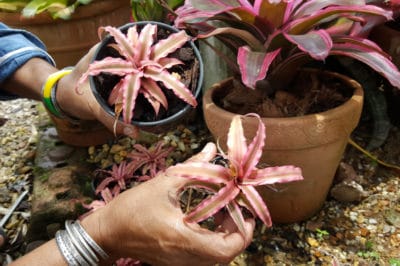Types of Bromeliads
Bromeliads have three growth styles. These are:
- Terrestrial – this form grows on the ground; the commercial pineapple is a good example of this type.
- Saxicolous – these bromeliads (lichens are in this group) attach themselves to rocks.
- Epiphytic – colloquially known as air plants, these get nourishment and water from the air. Spanish moss is an example.
How Bromeliads Reproduce
Many bromeliads can produce seeds. This is more likely in wild settings, as the plant must have just the right conditions as well as insects or birds (usually hummingbirds) for pollination. Saxicolous bromeliads are more likely to reproduce with stolons. The epiphytic and terrestrial bromeliads are usually propagated with pups, which are usually not produced until after the plant has flowered.
Growing Conditions
Bromeliads will not produce pups unless they have the right growing conditions. They need bright, indirect light (not full sun). Most prefer temperatures between 65°F (18°C) to 90°F (32°C) during the day and 50°F (10°C) to 65°F (18°C) at night. They want to dry out in between waterings and don’t like wet feet, so soil should drain well. However, they also like plenty of humidity in the air.
When Bromeliads Pup
Most bromeliads won’t flower until they are about three to five years old. The bloom is long-lasting – several months in most cases – but the plant dies within a year or two of blooming. However, to compensate, it produces one or more pups to become the new generation. Let the pup grow until it is at least one third the size of the mother plant before dividing them.
Repotting Pups
Cut the pup from the mother with a clean, very sharp knife. Cut into the mother, not the pup itself. The cut should be straight down and should go into the soil to include the roots of the pup. Place the pup in a new pot at the same level as it was in the old pot. Water, let drain and place in bright indirect light.
When a Pup Has No Roots
Sometimes the pup will not develop roots even though it has reached a size to be repotted. However, epiphytic bromeliads in particular seem to use their roots to anchor themselves rather than for nutrients. Some growers recommend waiting until roots develop. Others remove the pup and plant it anyway, providing a prop to stabilize the pup until roots develop.
